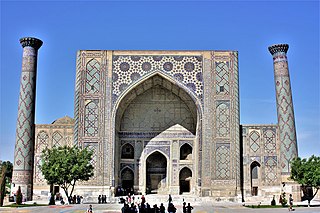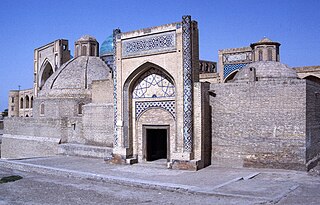
Bukhara is the seventh-largest city in Uzbekistan by population, with 280,187 residents as of 1 January 2020. It is the capital of Bukhara Region.

The Registan was the heart of the city of Samarkand of the Timurid Empire, now in Uzbekistan. The name Rēgistan (ریگستان) means "sandy place" or "desert" in Persian.

Bukhara Region is a region of Uzbekistan located in the southwest of the country. The Kyzyl Kum desert takes up a large portion of its territory. It borders Turkmenistan, Navoiy Region, Qashqadaryo Region, a small part of the Xorazm Region, and the Karakalpakstan Republic. It covers an area of 40,216 km2. The population is estimated at 1,976,823 (2022), with 63% living in rural areas.

The Ulugh Beg Madrasa is a madrasa in the historic center of Samarkand, a UNESCO World Heritage Site in Uzbekistan. Together with other monuments, it forms the monumental ensemble of Registan, the old heart of the city. It was built between 1417 and 1421 by the then-Timurid governor of Samarkand, Ulugh Beg, Timur's grandson and prominent astronomer, who was later emperor between 1447 and 1449.

The architecture of Uzbekistan combines ancient traditional design and innovative features adapted to the climate. Centers of Uzbek architecture are Samarkand, Bukhara, Khiva, Shakhrisabz, Termez, and Kokand. A number of ancient architectural masterpieces have survived, including palaces, mausoleums, mosques, and minarets. Colorful mosaics, religious symbols, and abstract geometrical patterns also characterize architecture in Uzbekistan.

Khoja Abdulkhalik Gijduvani Complex is an architectural monument located in the city of Gijduvan, Bukhara Region. The complex is located 50 km from the city of Bukhara and was built by Abdukholiq ibn Abdujalil Gijduvani, the founder of the Khojagan sect. The complex consists of the mausoleum of Khoja Abdulkhaliq Gijduvani, the Ulugbek Madrasah, a mosque and a pool. Khoja Abdulkhaliq Gijduvani is the first representative of seven pirs in Bukhara. He became known as Khojai Jahan and founded the school of Sufism. In 1433, Timurid Mirza Ulugbek built a madrasa in front of the shrine of Khoja Abdulkhaliq Gijduvani. In 2003, the 900th anniversary of Khoja Abdulkhaliq Gijduvani was widely celebrated. The Ulugbek madrasah in the complex was distinguished by its appearance. A mosque was built in this complex during the reign of Shaibani Ubaydullah Khan of Bukhara (1539–1550). In 1583, the madrasa and mosque were renovated during the reign of Bukhara Khan Abdullah Khan II (1583–1598). Verses 1-7 of Surah Alaq were mentioned on the facade of the Mirzo Ulugbek madrasah. These notes were written in suls script. However, most of them have collapsed. In 1946, certain part of the Mirzo Ulugbek madrasa records were read and accordingly it was restored. The tombstone of Abdukholiq Gijduvani was made of stone and the eleventh verse of Surah "Mujodala" from the Quran was written on the sides. On the short sides of the tombstone, an epitaph was written. The mosque in the complex of Khoja Abdulkhaliq Gijduvani was rebuilt in 2003. Nowadays, all the conditions for pilgrims have been created in the complex of Khoja Abdulkhaliq Gijduvani.
Muso Yoldoshevich Saidjonov was an Uzbek state and public figure. He was a representative of the Jadid movement in Bukhara, an educator, a historian, an orientalist and a numismatist, an archaeologist-professor. He was one of the first Uzbek professors.

Nodir Devonbegi is a historical memorial in Bukhara, Uzbekistan. It was established by Nodir Devonbegi, the vizier and brother of the ruler of Bukhara, Imamquli Khan, in 1620–1621. The Khanaka has been included in the national list of intangible cultural heritage objects of Uzbekistan.

Nodir Devonbegi Khanqah is a historical monument in the city of Bukhara, Uzbekistan. It was built by Nodir devonbegi, who was the vizier and nephew of Imam Quli Khan, the ruler of the Bukhara Khanate, in the years 1620–1621. The khanqah, which is a type of building that served as a place of residence and worship for Sufi mystics, is included in the national register of immovable property objects of the material and cultural heritage of Uzbekistan.

Ulugbek Madrasah is a memorial to Abdul Khaliq Ghijduwani, located in the city of Gijduvon in the Bukhara region of Uzbekistan. It is one of the ancient and renowned madrasas of Bukhara, also known as the "Fayziya Madrasah." Presently, it is also referred to as the Mirzo Ulugbek Madrasa. This prestigious educational institution was built in the Hijri year 836 beside the grave of Shaykh Abdul Khaliq Ghijduwani, with a two-story structure made of baked bricks. The Ulugbek Madrasah, established by Ulugh Beg, is the third and last madrasa he founded, relatively smaller and simpler compared to the Ulugbek Madrasah in Bukhara and Samarkand.
Domulla Sher Madrasah is located in Bukhara. The Madrasah has not been preserved today. Domulla Sher Madrasah was built by Domulla Shermuhammad in the 19th century under Khoja Zomuchi, during the reign of Amir Haydar, who ruled the Bukhara Emirate. Research scientist Abdusattor Jumanazarov, studied a number of foundation documents related to this Madrasah and provided information related to the Madrasah. According to the foundation documents, the Madrasah consisted of 15 upper and lower rooms, a classroom, a mosque, a toilet and a mustahabkhana. There was a Kokaldosh Madrasah and a street in the west of the Madrasah, a street and a courtyard in the north and east, and a courtyard of Muhammad Salim in the south and a road leading to the Kokaldosh Madrasah. This Madrasah was supported by the foundation itself. At the end of the 19th century, Mullah Nabirahoja taught in the Madrasah. During the Soviet period, in 1922, the Domulla Sher Madrasah was turned into a prison. Domulla Shermuhammad was one of the prominent scholars of his time. He reached the level of recitation and taught at the Kokaldosh madrasa. He is originally from Kogan and lived in Bukhara for many years. He received his knowledge from Shaykhul-Islam Atoullah Khoja ibn Hadikhoja. Domulla Shermuhammad became blind at the end of his life. He died in 1824 at the age of 86 Sadri Zia wrote that there were 49 rooms in this Madrasah. The research scientist Abdusattor Jumanazarov, based on the documents of the foundation, indicated that the Madrasah consists of 19 rooms. Domulla Sher Madrasah consisted of 19 rooms. This Madrasah was built in the style of Central Asian architecture. The Madrasah is built of brick, wood, stone and ganch.

Abdullakhan madrasah is an architectural monument located in the north of the Koshmadrasa ensemble in Bukhara, Uzbekistan. This madrasah, which is a perfect example of the architecture of the Uzbek ruler Abdullah II, demonstrates all the creative achievements of Bukhara architecture in the 16th century.

Amir Olim Khan madrasah is a madrasah founded in 1915 by the Mangite ruler Sayyid Mir Muhammad Alim Khan in Bukhara, Uzbekistan, then the capital of the Bukhara Emirate.
Ayozbi Madrasah is architectural monument built in Bukhara.
Khoja Nihol Madrasah was a historical monument built in Bukhara. The madrasah has not been preserved today.

Chuqur madrasah is a one-story madrasa building located in the historical center of the city of Bukhara, Bukhara Region, Republic of Uzbekistan. It is included in the national list of real estate objects of material and cultural heritage of Uzbekistan.

Ibrahim Akhund madrasah is a two-story madrasah located in the historical center of Bukhara city, Bukhara region, Republic of Uzbekistan. It is included in the national list of real estate objects of material and cultural heritage of Uzbekistan. The Varakhsha Archaeological Museum is in the building.

Joybori Kalon Madrasah is located in Bukhara, Uzbekistan. During the reign of the Uzbek ruler Abdulaziz Khan (1645-1681), it was built in Havzi nav guzar of Joybor district in the capital of the Khanate under the donation of his mother Podshah. It was one of the most prestigious and prestigious madrasahs in Bukhara.

Nadir Devanbegi Madrasah is an architectural monument in Bukhara, Uzbekistan. It was built between 1622 and 1623 by Nadir Devanbegi, the minister of Bukhara Khan, Imam Quli Khan. Nadir Devonbegi madrasah is located in the old city of Bukhara. It is located in the eastern part of the Lyab-i Hauz. Currently, the madrasah is included in the national list of immovable property objects of the material and cultural heritage of Uzbekistan.
The Abdulaziz-Khan Madrasah is an ancient madrassah in Bukhara, Uzbekistan. Like the entire historic part of the city, it is listed as a UNESCO world heritage site. It owes its name to its founder, Abdulaziz Khan (1614-1683) who had it built in 1652-1654. It is part of an architectural ensemble, forming a koch (double) with the Ulugbek Madrasah (1417), located to the east of the jewelers' bazaar. Its exterior decoration is partly unfinished, because the Khan was dethroned while the decoration of the madrassah was not yet finished and the architect put an end to the project.















